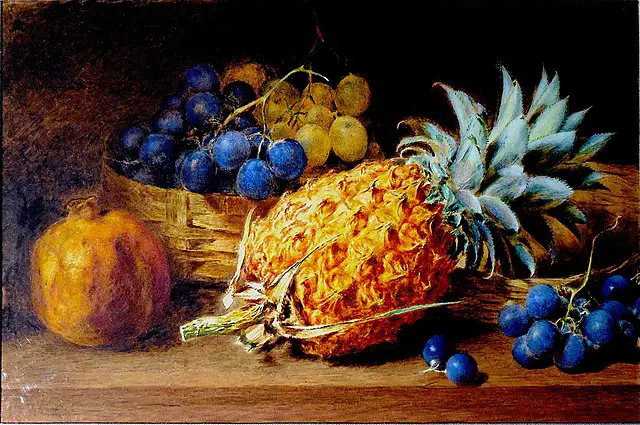It wasn’t gold. It wasn’t jewels. It was a pineapple.
In 1765, a fruit caused an international scandal. Not just any fruit, mind you. A pineapple. Spiky, golden, and oddly regal, the kind of thing that looks like it belongs on a velvet cushion rather than on your plate.
This is the story of how a single stolen pineapple sent shockwaves through colonial society, bruised egos, sparked rumors of espionage, and maybe, just maybe, helped plant the seed of resistance in a world that was already ripe with tension.
The Pineapple: Symbol of Power, Wealth, and Obnoxious Flexing
In the 18th century, pineapples were basically the Louis Vuitton of fruit.
They were rare, expensive, and ridiculously hard to grow in cold European climates. Only the absurdly rich had access to them. Nobles rented them by the hour for parties just to show off. Some never even ate them. They just… posed with them. Imagine renting a fruit for clout. That’s where we were as a species.
So when word got out that the British East India Company had managed to cultivate a pineapple on foreign soil, and was planning to showcase it during a diplomatic banquet in Calcutta, it wasn’t just fruit. It was propaganda.
It was the empire saying: Look what we can make grow in your land. Look how far our reach extends.
A Thief With Taste
No one expected the pineapple to vanish.
It was stored in a heavily guarded hothouse, kept under constant surveillance, and scheduled to make its debut at the Governor-General’s grand reception. But the morning of the banquet, it was gone.
Not sliced. Not stolen by monkeys. Straight-up vanished.
Panic set in. Was it sabotage? A prank? An inside job?
Some whispered it was the French, still bitter from their recent losses in India. Others accused local resistance fighters of mocking the British with what one newspaper called an “edible act of defiance.”
One British officer reportedly said, “We have lost more than fruit. We have lost face.”
The Hunt Begins (and Gets Weird)
Searches were launched. Servants were interrogated. Surveillance on market fruit vendors intensified to ridiculous levels. Imagine being accused of treason because your cart smelled vaguely tropical.
An illustrator in Bengal published a cartoon of a British officer chasing a pineapple across a rice field, sword drawn, face red. It circulated fast. Too fast. The Company banned it immediately, which of course only made it more popular.
Some say that cartoon reached London. That it landed on desks that had once planned sugar routes and tea taxes. That it made someone in a powdered wig ask: What else are we losing control of?
Did Anyone Actually Eat the Pineapple?
Good question.
Rumors swirled. One theory said a kitchen maid smuggled it out in her skirt and served it to her family, who had no idea they were devouring a symbol of empire. Another claimed it ended up as a gift to a Bengali poet who painted its likeness onto silk and burned the fruit, just to make a point.
Was it wasteful? Yes. Was it poetic? Absolutely.
No one ever confessed. No pineapple was ever found. And the banquet? It went on without its star.
Why It Mattered More Than It Should Have
Here’s where it gets serious.
The pineapple debacle exposed something. The British Empire, puffed up with ego, was deeply insecure. It was obsessed with appearances. With performance. That fruit wasn’t just dessert. It was a message.
And its disappearance? A rebuttal.
In the years that followed, more subtle acts of rebellion took shape. Not revolts, not riots. Just tiny ruptures. Punctures in the imperial balloon. A misdelivered telegram here. A translated pamphlet there. The little things that slowly shifted the tone of an era.
The Forgotten Fruits of Resistance
We don’t talk about the pineapple much anymore. It’s a footnote in most colonial histories, if it’s mentioned at all. But maybe it deserves more.
Maybe it reminds us that not all resistance is loud. Sometimes it’s juicy. Sometimes it smells sweet. Sometimes it slips past security dressed as dinner.
And sometimes, a single stolen pineapple says more about empire, pride, and the power of disruption than a thousand speeches ever could.
Sources:
1. “Pineapples and Power: Symbolism in the Colonial Garden” – Journal of Imperial Botany Studies (1766 reprint)
2. Dalrymple, William. The Anarchy: The Relentless Rise of the East India Company (Bloomsbury, 2019)
3. Eaton, Natasha. “The Politics of Taste: Exotic Fruit and Colonial Display” – Visual Culture Quarterly, 2020
4. Calcutta Courier archival illustrations, 1765–1766

